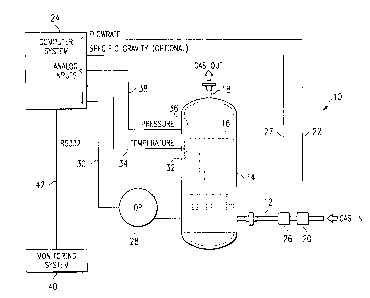Some of the information on this Web page has been provided by external sources. The Government of Canada is not responsible for the accuracy, reliability or currency of the information supplied by external sources. Users wishing to rely upon this information should consult directly with the source of the information. Content provided by external sources is not subject to official languages, privacy and accessibility requirements.
Any discrepancies in the text and image of the Claims and Abstract are due to differing posting times. Text of the Claims and Abstract are posted:
| (12) Patent Application: | (11) CA 2383979 |
|---|---|
| (54) English Title: | ON-LINE FILTER MONITORING SYSTEM |
| (54) French Title: | SYSTEME DE SURVEILLANCE EN-LIGNE DES FILTRES |
| Status: | Deemed Abandoned and Beyond the Period of Reinstatement - Pending Response to Notice of Disregarded Communication |
| (51) International Patent Classification (IPC): |
|
|---|---|
| (72) Inventors : |
|
| (73) Owners : |
|
| (71) Applicants : |
|
| (74) Agent: | KIRBY EADES GALE BAKER |
| (74) Associate agent: | |
| (45) Issued: | |
| (86) PCT Filing Date: | 2000-09-13 |
| (87) Open to Public Inspection: | 2001-03-22 |
| Availability of licence: | N/A |
| Dedicated to the Public: | N/A |
| (25) Language of filing: | English |
| Patent Cooperation Treaty (PCT): | Yes |
|---|---|
| (86) PCT Filing Number: | PCT/US2000/025038 |
| (87) International Publication Number: | WO 2001019495 |
| (85) National Entry: | 2002-03-05 |
| (30) Application Priority Data: | ||||||
|---|---|---|---|---|---|---|
|
A monitoring system (10) is disclosed for monitoring the condition of a filter
(16) filtering a gas or liquid. Using various sensors, the permeability of the
filter is monitored on a continuous basis. A significant increase in
permeability, decrease in permeability or rate of change of permeability can
lead to an indication of filter failure, such as rupture, leakage, loading and
unloading. The system can be monitored by a computer and monitored from a
remote location through phone lines and Internet computer systems.
La présente invention concerne un système de surveillance (10) servant à surveiller l'état d'un filtre (16) traitant un gaz ou un liquide. L'utilisation de diverses sondes permet de faire un suivi permanent de la perméabilité du filtre. Toute augmentation ou diminution notable de la perméabilité ou du gradient de variation de la perméabilité peut amener à la conclusion que le filtre présente un problème tel qu'une rupture, une fuite, une saturation ou une dépose. La surveillance du système peut se faire au moyen d'un ordinateur, éventuellement hors site via des lignes téléphoniques et des systèmes informatiques raccordés à l'Internet.
Note: Claims are shown in the official language in which they were submitted.
Note: Descriptions are shown in the official language in which they were submitted.

2024-08-01:As part of the Next Generation Patents (NGP) transition, the Canadian Patents Database (CPD) now contains a more detailed Event History, which replicates the Event Log of our new back-office solution.
Please note that "Inactive:" events refers to events no longer in use in our new back-office solution.
For a clearer understanding of the status of the application/patent presented on this page, the site Disclaimer , as well as the definitions for Patent , Event History , Maintenance Fee and Payment History should be consulted.
| Description | Date |
|---|---|
| Inactive: IPC from MCD | 2006-03-12 |
| Application Not Reinstated by Deadline | 2004-09-13 |
| Time Limit for Reversal Expired | 2004-09-13 |
| Deemed Abandoned - Failure to Respond to Maintenance Fee Notice | 2003-09-15 |
| Letter Sent | 2002-11-04 |
| Inactive: Single transfer | 2002-09-17 |
| Inactive: Cover page published | 2002-09-04 |
| Inactive: Courtesy letter - Evidence | 2002-09-03 |
| Inactive: Notice - National entry - No RFE | 2002-08-29 |
| Application Received - PCT | 2002-06-08 |
| National Entry Requirements Determined Compliant | 2002-03-05 |
| Application Published (Open to Public Inspection) | 2001-03-22 |
| Abandonment Date | Reason | Reinstatement Date |
|---|---|---|
| 2003-09-15 |
The last payment was received on 2002-08-16
Note : If the full payment has not been received on or before the date indicated, a further fee may be required which may be one of the following
Please refer to the CIPO Patent Fees web page to see all current fee amounts.
| Fee Type | Anniversary Year | Due Date | Paid Date |
|---|---|---|---|
| Registration of a document | 2002-03-05 | ||
| Basic national fee - standard | 2002-03-05 | ||
| MF (application, 2nd anniv.) - standard | 02 | 2002-09-13 | 2002-08-16 |
Note: Records showing the ownership history in alphabetical order.
| Current Owners on Record |
|---|
| PEERLESS MFG. CO. |
| Past Owners on Record |
|---|
| KENNETH J. FEWEL |